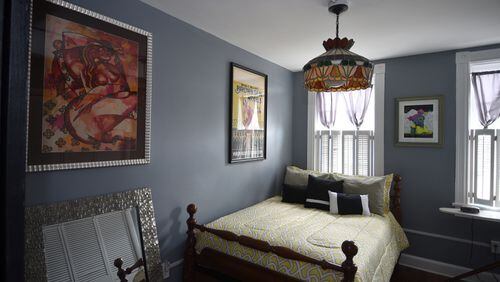BALTIMORE — After years of living away from his native Baltimore, Gregory Morton was looking for a hometown haven. Little did he know that his search would lead to a property so filled with history that he would be proud to share it with the world.
Today, home for the 35-year-old Morton is one of five alley houses on the street that abolitionist Frederick Douglass had built in the 1890s.
Douglass, who was born into slavery on the Eastern Shore and went on to become a world-renowned orator, author and newspaper editor, built the homes as rental properties for African-Americans, according to the Maryland Historical Trust.
“One of the curses of our race is poverty,” said Douglass just a few months before buying the Dallas Street property for $1,800 in 1892, according to a contemporary Baltimore Sun account. He urged his audience to invest. “Money is not exactly the root of all evil. We must acquire property, and we must leave something.”
A century later, Morton has taken on what Douglass left behind, filling the one-bedroom Fells Point house with rotating artworks that celebrate African-American culture, as well as opening his home to the public via online platforms like Airbnb and Instagram.
Morton, who works in finance, said he first learned about the two-story “Douglass Place” during the summer of 2015. His mother, Pam, saw that the home was up for sale while watching the news.
She immediately called her son, she said, urging him to look at the home on The Baltimore Sun website, where the newspaper featured a gallery of photos and information on the home.
Morton was excited, but once he got more information, he had second thoughts, he said. The home — not including the price of required renovations — was more expensive than he had thought, and it was located on a small alley street with no parking.
But “this is Frederick Douglass’ house,” Morton recalls saying to himself. “I can’t even pass it up. … It’d be silly not to get it.”
Morton pursued the house, learning that while he could make any renovations he wanted to the interior, there were restrictions to renovations to the exterior because it had been designated a historic landmark. The home went through state inspections, and Morton filed a proposal including his renovation plans for the home with the Fell’s Point Design Review Committee.
Once his plans were approved, he closed on the home for $145,000 in December 2015 and began renovations in early 2016.
He kept the original hardwood floors, exposed brick and tight, winding staircase Douglass had had installed, but put in new windows and painted the interior in a black-and-white color scheme that would go with the renovated kitchen’s stainless-steel appliances and complement the artwork he’d later display in the space.
The 902-square-foot home has two floors with a basement that functions as a utility room. The first floor has a living room with original hardwood floors, exposed brick and a fireplace, decorated with artwork paying homage to Nina Simone and Muhammad Ali. The first-floor kitchen, newly renovated by Morton, features stainless-steel appliances and black cabinets. A door from the kitchen leads to a simple back patio with a table and chairs, and a side garden planted by Morton’s mother.
The winding staircase that Douglass had installed leads from the first floor to the second, where there is a full bathroom with an antique clawfoot tub and vintage trunk on one end, and a small sitting area with a chalkboard sign that reads “Welcome to the Douglass House!” on the other. The room has a sofa bed, a colorful coffee table, a red school locker, a desk and books, and leads to the bedroom, which features prints by black artists Romare Bearden and Hebru Brantley and vintage finds like a stained-glass lamp and an antique ironing board.
Developing the eclectic interior decor became a family project for Morton and his parents, Pam and Elvis Morton. Together, they roamed the city in a search for items that would blend with Morton’s vision for the house — an homage to Douglass, Baltimore and black expression, he said.
“I collect artwork. I’m a black man, and I like representations that are positive,” said Morton of the featured works of art, which are a blend of secondhand finds and art that he had collected before buying the home.
There are Aunt Jemima-like salt and pepper shakers and a cookie jar from 1920, African masks, light switch covers depicting African-American scenes, and strategically placed copies of African-American literature, including Tupac Shakur’s collection of poetry, “The Rose That Grew from Concrete,” and Douglass’ third autobiography, “Life and Times of Frederick Douglass.”
There are odes to singers Simone and Billie Holiday in the form of paintings by Baltimore artist Loring Cornish, playbills from African-American plays, a rare 1975 “Cooley High” movie poster, and works by black artists like Jacob Lawrence.
Then, there are symbols of Baltimore — pictures of local sports mascots, Mr. Boh, and a stained-glass transom Morton said he found in the home’s basement after his move. (It now frames the wall of the first floor’s half-bathroom.)
“I want to make sure I have a connection to the local community,” he said.
An 1882 map of Fells Point hanging on the first-floor wall marks a significant point in Douglass’ life. On it, Morton points to the Philadelphia, Wilmington and Baltimore Railroad — the railroad that Douglass used when he made his escape from Baltimore and slavery in the late 1830s. Morton’s home is located just steps away from where the tracks used to be.
“With [the house’s] great African-American history, I kind of felt like I should share it with people. I thought it was the right thing to do,” said Morton, who often sees tours coming through Dallas Street, formally known as Strawberry Alley, to view the homes.
In January, Morton listed the home on vacation and housing rental websites Airbnb and HomeAway, seeing whether others would be interested in staying in a piece of city history.
Within five days, Morton said, he had bookings all the way through June — with history buffs, artists, doctors, professors and tourists looking to experience the city with a stay in Douglass’ property.
Morton was gratified by the interest, but “it took away my personal space” on weeks when it was being rented out and he had to find another place to stay, he said. Eventually, he put a hold on requests, limiting the home’s availability to two weeks of every month.
In June, Morton began to share the home and Douglass’ legacy in another way, creating the Instagram page @douglass.house.bmore, where he posts pictures of the home, sharing its artwork and artifacts with Baltimore and beyond.
Interest is growing, and Morton is pleased with his rotating decor, but his work is not done, he said.
Nearly every week, Morton is at the Enoch Pratt Free Library, going through newspaper archives and searching for more information about the home, Douglass and Fells Point, in hopes of expanding visitors’ knowledge of Douglass and Baltimore. In fact, owning the home has helped expanded his own knowledge.
“I’m experiencing Baltimore for the first time in this regard,” he said. “And it’s a lot of fun actually.”






